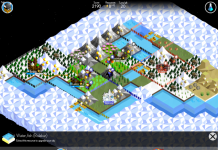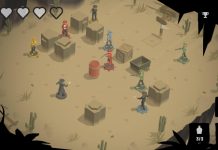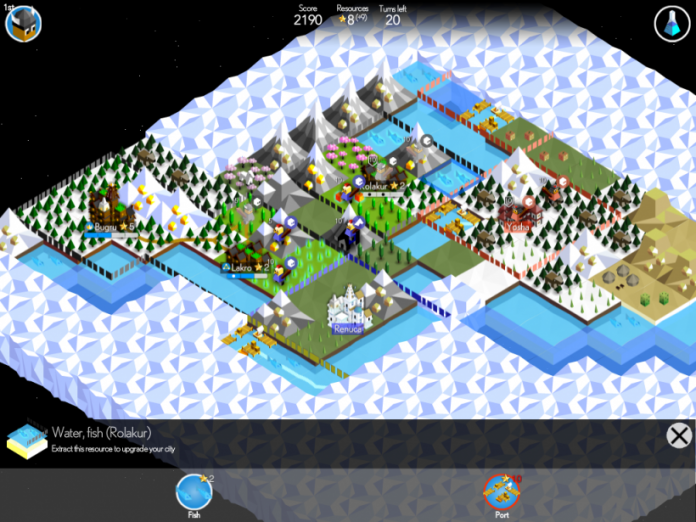This last week I have been spending a significant amount of time building small and short-lived empires on my iPhone. My last review for the site was Planar Conquest and Battle for Polytopia, the freshman release from Swedish indie studio Midjiwan, is the polar opposite of that game. Polytopia tasks you to take a tribe and expand it to build the highest score you can in 30 turns essentially making this a 4X speed-run with cute pixelblock animation. It is the 4X experience fine-tuned and narrowed for mobile and as it turns out, a challenging and rewarding take on the traditional 4X game.
Your world in Polytopia is a 15×15 square grid and you take charge of one of four tribes–a fifth is available via IAP–and have 30 turns to make the most of the randomly generated world you are given. There are no victory conditions, there is only the quest to get the highest score you can in whatever way you can or want.
You start the game by choosing a tribe from the Xinxi (who start with Climbing tech), the Imperius (who have Organization), the Bardur (Hunters), the Oumaji (Riders), or the Kickoo (Fishing). Other than your starting tech, your choice of tribe also influences the type of terrain your first city is in, but this doesn’t have as much of an impact as you would expect. Except for water and mountains the terrain only influences what type of food grows nearby. After choosing a tribe you pick the number of tribes you want to compete against (from 1 to 3) as well as the difficulty level (Easy, Normal, Hard and Crazy).
You start with a single city and a single warrior and explore outwards to find neutral villages which you can settle or, more likely, other tribes. The other tribes inhabiting your terrarium of a world are always happy to meet you and will give you new technologies or even money. This easy-going attitude will quickly change though as the AI controlled tribes are very fickle and will attack at the slightest provocation. The wisdom of Dr. Leonard McCoy is something to take heed of.
The truncated game space comes with a suitably reduced tech tree with 21 individual technologies to research. These technologies are available to all tribes and are arranged in a circular tree which limits the order in which new techs can be researched. Technologies open up new units, new improvement types (mines, roads etc) and also unlock tasks. Tasks reward you with additional points and are an important tool for increasing your score. For example, the Pacifist task rewards you for not attacking other tribes for five turns. If you haven’t noticed, Polytopiaborders on being a puzzle game with a 4X bent. It requires you to take whatever starting conditions you are given and manipulate the tools you’re given to ratchet up your score into the hundreds of thousands.
Your empire expands through conquest, either by subjugating defenseless villages, or by sieging cities that belong to the other tribes. There are no Settler units in the game so expanding your empire is a sure way to draw the ire of your neighbors. Finding villages is one of your immediate goals and can quickly change your game plan based on their numbers and distance from your starting city.
As you gather food from the local flora and fauna, your population in each town will increase, updating that city. Each update will offer a choice between two upgrades which you can apply to the burgeoning metropolois. Things like increased resource production, free resources, city walls and expanded borders. The ultimate expansion upgrade is the Giant unit which visually, and in terms of its stats, dwarfs the other units in the game and is the quickest way to conquer your opponents (aside from a swarm of warriors and archers in boats — but the less said about that particular tactic the better).
The world is randomly generated for each new game and it can often create unique challenges. In one game I played, all four tribes started on the same small continent while a second, larger and more abundant, continent was left uninhabited. I’ve also started several games totally surrounded by water, or surrounded by opponents, and even far off in one corner of the map on my own. Randomly getting handed a terrible starting spot in any other 4X game would be an issue. With Polytopia‘s 30-turn clock in effect, it’s less so. Instead of ruining your game, poor starts can be viewed a challenge, and one that will end in 20 minutes and not three days.
There is just enough strategy in the game to require you to be careful of your attacks and movement, especially in the mid-game, and the random world generation gives you a fresh challenge each time. The difficulty levels are well structured, “Hard’ is indeed more difficult than ‘Easy’ and ‘Crazy’ is, well, crazy. The AI, unfettered by thoughts of diplomacy and trade, is aggressive. Strategy also comes into play when you upgrade your cities. Some upgrades–like forges and lumber mills–only work when situated next to specific types of land or other upgrades.
Polytopia plays in portrait or landscape mode which makes playing on the iPad especially easy. The graphics can be slightly difficult to see at times, however, and the game doesn’t offer much range in terms of zooming in to see the details.
Due to its stripped-down nature, Battle for Polytopia doesn’t offer you varied win conditions like other 4X titles. It doesn’t even actually have a victory condition at all. Just the final score and your ability to max it out based on the particular conditions of your current game. The one major flaw with the game is that it doesn’t remember your scores and only displays scoreboards for the best daily, weekly and overall scores from all the players. Unless you are a top-player of the game you’ll never see your score again after a game is over. It would be much better if the game tracked your local scores as well. In all the time I have played I have never even been close to appearing on any of the leaderboards and so some method to gauge my own progress in the game would be a welcome addition.
Battle for Polytopia also has no documentation. Aside from the in-game unit stats and pop-ups, you’re on your own when it comes to unraveling the game. It’s not always obvious what units do, or what exceptions they provide. Most units can attack an adjacent enemy unit after they move. Except Giants. Attacking ends your turn, except for Riders who can still move afterwards. There aren’t a lot of these special rules but they do take a few games to figure out and can throw a wrench into your plans during your first few games. The tribes provide a different starting technology and different visual look to your cities but aside from that they are largely interchangeable.
Even with these minor issues, Battle for Polyopia is close to being a perfect mobile title. It takes the essence of a more expansive type of game and creates a 4X au jus which has left me clamouring for more after each game. Midjiwan has said they will be continuing to work on the game and one can only hope that they will offer a larger–but not too large–version of this game in the future.






















